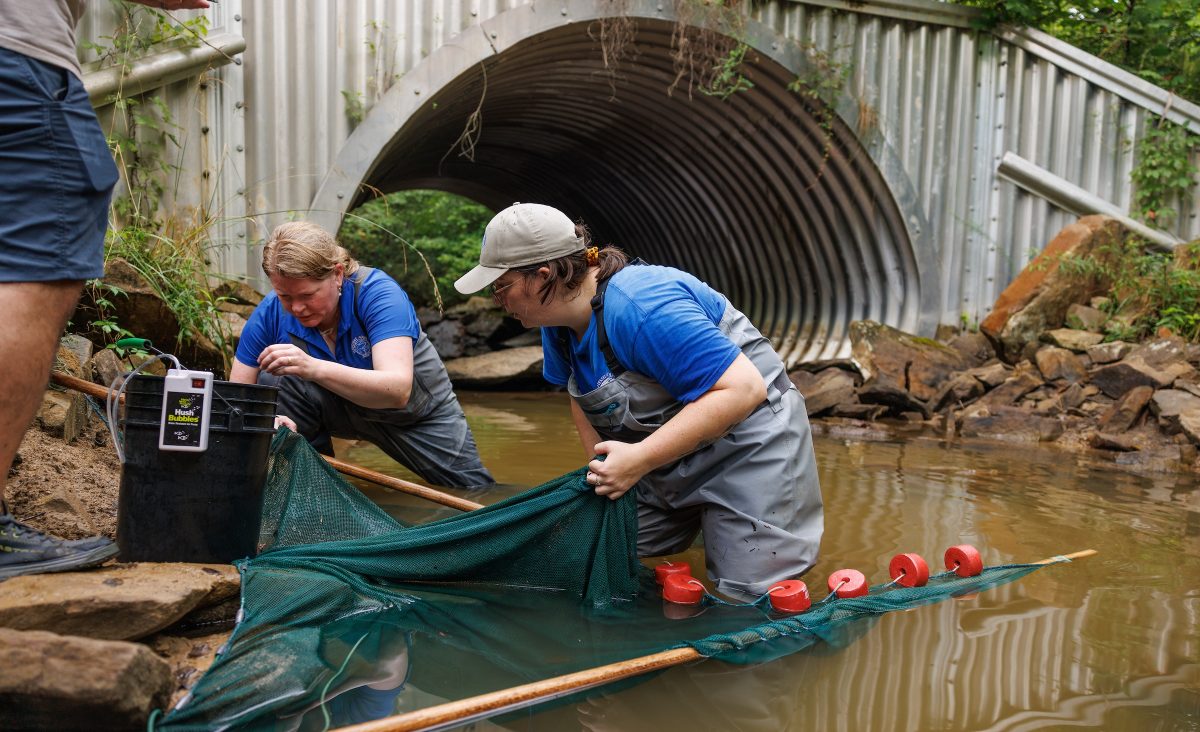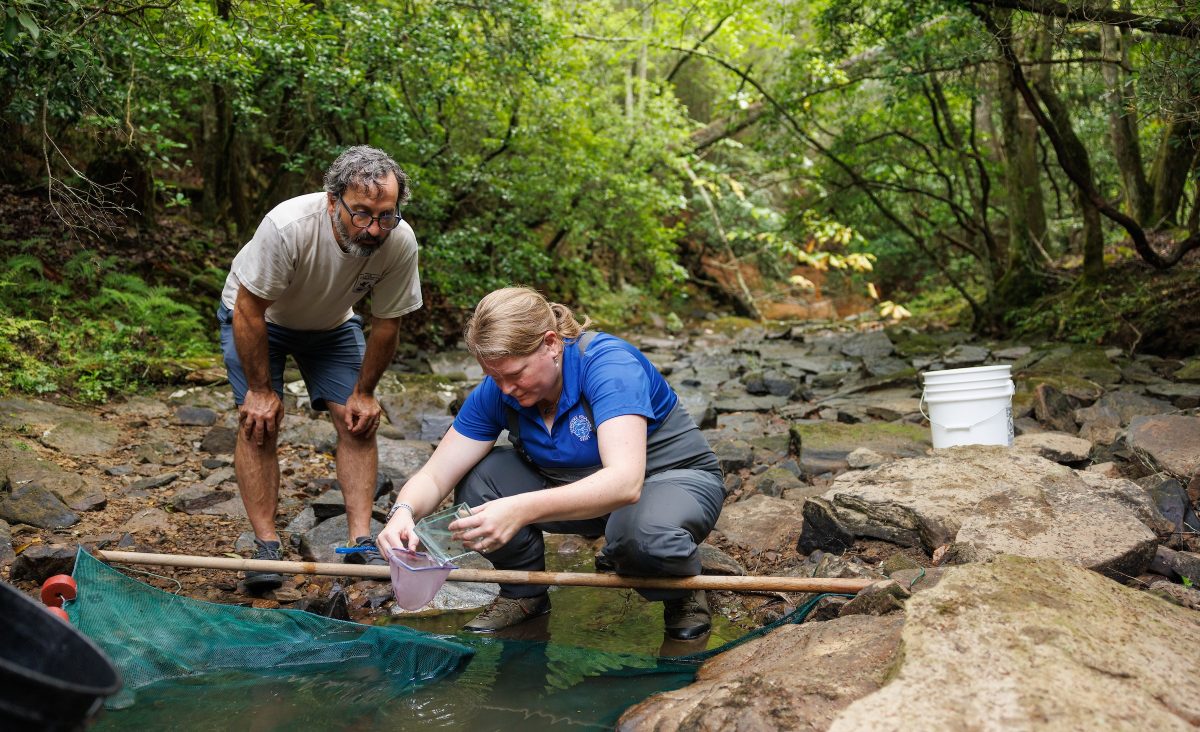Chattanooga, Tenn. (Aug. 22, 2024) – Few things trigger louder or more distressing alarm bells among freshwater biologists than watching a waterway dry up during a severe, prolonged drought. That’s especially true when the disappearing stream is home to one of America’s most-imperiled fish.
In late July, reports of dramatically withered streams atop Walden Ridge north of Chattanooga spurred an emergency rescue operation to prevent the extinction of the federally endangered Laurel Dace, which scientists consider to be among the 10 most-at-risk fish in North America.
This effort was carried out by representatives from the Tennessee Aquarium, the U.S. Fish and Wildlife Service, and the University of Georgia’s River Basin Center in coordination with the Tennessee Wildlife Resources Agency. In all, 105 adult Laurel Dace were removed from dangerously dry streams and successfully relocated to the Tennessee Aquarium Conservation Institute (TNACI) near downtown Chattanooga.
All but one of the collected fish survived the relocation and are now thriving in temporary human care, where they will remain until conditions in their few native streams are sufficiently improved for them to be returned safely.
“The Laurel Dace are doing great,” says Abbey Holsopple, the Aquarium’s recovery biologist. “They almost seem relieved to have fresh, clean water and plentiful food sources, which they weren’t getting in the wild during the drought.”
Even if it’s in the species’ best interest, any decision by wildlife managers and biologists to remove an animal — especially one as endangered as the Laurel Dace — from its home is not entered into lightly.
Relocation carries inherent dangers, from injuries and stress during transport to adverse reactions to different foods, temperature, or water chemistry while in human care.

VP, Chief Conservation & Education Officer Dr. Anna George, left, and Recovery Biologist Abbey Holsopple collect critically endangered Laurel Dace from Bumbee Creek.
On the other hand, drought conditions can lead to higher water temperatures, lower oxygen levels, reduced access to food and crowded living conditions, all of which are daunting challenges for fish to overcome.
“The fish in the stream can get trapped into these pools with nowhere to go,” Holsopple says. “Imagine if you were at a concert and you’re surrounded by people on every side of you. You’re rubbing up against each other. It’s hot; it’s uncomfortable.
“Spending every single day of your life with that many people around you just increases the stress and can lead to issues like disease.”
Weighing the risks of removing Laurel Dace against the danger of letting them ride out the drought, the Aquarium and its partners decided the species needed their help more than it needed to be left alone.
“When you’re a conservation biologist, you’re working with these critically endangered species, which is kind of like having a patient who’s in the ICU,” says Dr. Anna George, the Aquarium’s vice president of conservation science and education.
“What really weighed heavily on us was knowing that, given how critically endangered the Laurel Dace is, inaction could have led to the permanent extinction of this species.”
With its golden-striped flanks, red belly, highlighter yellow fins, and crimson lips, the Laurel Dace is like a living statement piece for the under-celebrated beauty of freshwater fish.
The U.S. Fish and Wildlife Service first identified the Laurel Dace as a species potentially in need of protection under the Endangered Species Act (ESA) in the early 2000s. It posted notice that it was elevating the Laurel Dace to candidate status for listing in 2007. In 2011, the Laurel Dace’s endangered listing was finalized, and the Service has been monitoring the remaining populations along with the Aquarium and other partners ever since.
As recently as 2012, Laurel Dace were still found in five streams flowing along Walden Ridge, but 12 years of rampant habitat degradation have reduced the species’ range to two of these waterways.
The rescue took place in one of these last refuges, but the drought had reduced it from a normally idyllic mountain stream to a desiccated ghost of itself. The few remaining pools were little more than glorified puddles, the little water that remained rarely deep enough even to moisten the rescuers’ socks. What fish they held, more often than not the similar-looking Western Black-nose Dace, swam bunched together, drought-stranded in conditions that were dismally shallow and often sediment-choked.

Tennessee Aquarium VP, Chief Conservation & Education Officer Dr. Anna George, right, and U.S. Fish & Wildlife Service Conservation Delivery Coordinator Geoff Call collect critically endangered Laurel Dace from Bumbee Creek.
The Endangered Species Act normally prohibits the removal of federally endangered animals from the wild, but the Aquarium is permitted to do so as part of its participation in Laurel Dace’s recovery efforts. This latest rescue called for the relocation of more individuals than allowed under that permit, but U.S. Fish and Wildlife Service biologists are empowered to make exemptions in dire cases to prevent damage to a species.
That these fish were safely collected within a couple of hours and overwhelmingly survived relocation to TNACI speaks to the abundance of preparation made on the front end and the expertise of those involved, says U.S. Fish and Wildlife Service Conservation Delivery Coordinator Geoff Call.
“The collections were done in the safest way possible for the fish, which gave me confidence that we would get the best outcome that could be hoped for,” he says. “The fact that we ended up losing only one out of 105 fish is a testament to the capabilities of the staff from the Aquarium who came and worked with the Service to do the rescue.”
Ultimately, the goal of the rescue is not to house the Laurel Dace permanently in human care but to offer temporary sanctuary to ensure their survival during the drought. How long this foster care arrangement lasts is largely dependent on the weather.
Despite scattered precipitation events throughout Southeast Tennessee in the last few weeks, substantial rain hasn’t fallen on Walden Ridge since early June. With no rain in the long-range forecast, drought conditions may worsen in weeks to come and could linger until the return of wetter weather in the late fall or early winter.
Scientists and representatives of the U.S. Fish and Wildlife Service are conducting regular site visits to the streams on Walden Ridge to keep an eye on conditions in case waterways improve faster than anticipated.
Whatever the timeline for the Laurel Daces’ return to the wild, their homecoming will be a high-water mark for the biologists who are so invested in the species’ survival, Holsopple says.
“Days like the day when we get to bring the Laurel Dace back to the stream are the ones that keep us going,” she says. “We get to feel the success of actually protecting this fish from something that could have caused its extinction and feel the joy that that comes from saving them for the future.”